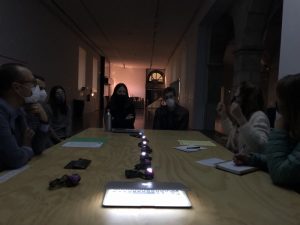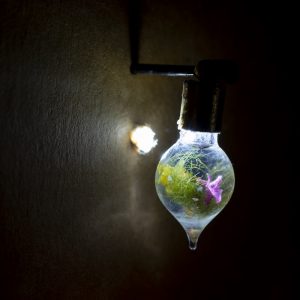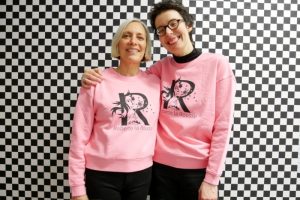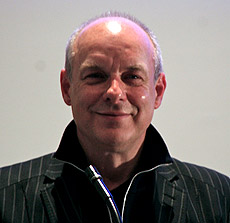 The University of the Arts Berlin gave Brian Eno their first 01 award in 1998, honouring his often visionary activities in both music and visual arts. The honoraries return every now and then for workshops and lectures and last Thursday, Eno gave a talk which was titled Before and after Darwin. Here’s a recap:
The University of the Arts Berlin gave Brian Eno their first 01 award in 1998, honouring his often visionary activities in both music and visual arts. The honoraries return every now and then for workshops and lectures and last Thursday, Eno gave a talk which was titled Before and after Darwin. Here’s a recap:
According to Eno, pre-Darwin imperial Britain looked something like this: There was God, then came the king, gentlemen, horses, women and last the French. This represents a classic pyramid-shaped model of organization and enlightenment. Information flows in one direction where intelligence is at the top and gets diluted on the way down to the bottom. An example of this model is the classical idea of the musical genius as impersonated in Giotto, Beethoven or Bach at the top and “bad” art like folk and pop music at the bottom. In his view, this is an image that too often still permeates the art world. In 1859, Charles Darwin published his book The Origin of Species and suddenly the idea of evolution stood in the room, which is actually stunningly counterintuitive – behind a complex object, as many immediately assume, there must be a greater intelligence that the object itself.  If you take a Boeing 747 as an example, it would be quite natural to assume that something more complex that the 747 must exist on top of it. Darwin however, stated that complexity comes from the bottom up and at no point we would need to assume that it requires a more complex intelligence above it – there is no head of the pyramid anymore because information flows from the bottom up. This bottom-up design also became an integral part of cybernetics and later of computer science.
If you take a Boeing 747 as an example, it would be quite natural to assume that something more complex that the 747 must exist on top of it. Darwin however, stated that complexity comes from the bottom up and at no point we would need to assume that it requires a more complex intelligence above it – there is no head of the pyramid anymore because information flows from the bottom up. This bottom-up design also became an integral part of cybernetics and later of computer science.
Darwin was a religious person and, according to Eno, this was one of the reasons why he didn’t explore the implications of his findings to the full extent, God and the idea of a divine order in nature a sense stayed on top of the creation for more than another century until a second insight appeared through the notion of ecology: Everything is interconnected, there is not only no bottom but just a web of nodes. The consequence that was brought about by many different researchers, notably Rachel Carson’s groundbreaking work Silent Spring on the use of DDT, was that you can never do one thing in nature. This gave birth to many sciences and, what many don’t realize, it has also given rise to a lot of different forms of art.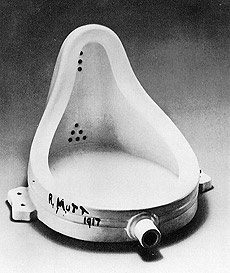 The mentioned picture of Bach, sitting alone in a room, possibly communicating with God had already been shattered by 20th century artists like Duchamp who regarded their work as “a deliberate act of aesthetic indifference”. (Brian Eno inserted a description how he apparently was the first person to actually pee into Duchamp’s famous readymade Fountain at the MOMA. Quoting his book A Year With Swollen Appendices: “I positioned myself before the display case, concentrating intensely on its contents. There was a guard standing behind be and 12 feet away. I opened my fly and slipped out the tube, feeding it carefully through the slot in the glass. It was a perfect fit and slid in quite easily until its end was poised above the famous john. I released my thumb and a small but distinct trickle of my urine splashed on the work of art.”)
The mentioned picture of Bach, sitting alone in a room, possibly communicating with God had already been shattered by 20th century artists like Duchamp who regarded their work as “a deliberate act of aesthetic indifference”. (Brian Eno inserted a description how he apparently was the first person to actually pee into Duchamp’s famous readymade Fountain at the MOMA. Quoting his book A Year With Swollen Appendices: “I positioned myself before the display case, concentrating intensely on its contents. There was a guard standing behind be and 12 feet away. I opened my fly and slipped out the tube, feeding it carefully through the slot in the glass. It was a perfect fit and slid in quite easily until its end was poised above the famous john. I released my thumb and a small but distinct trickle of my urine splashed on the work of art.”)
In the 1960s, John Cage and others started to work with chance. When you let chance operate, something beyond the filters is allowed to come through. Even more so, you will make things that are beyond your own predictions. This excited Eno for almost 30 years in which he kept inventing systems by which the art can make itself. He started doing it in a simple way with Discreet Music, taking two melodies of slightly different length to create two harmonies in what would be called a moiré pattern in visual arts. It’s a very small input, leading to an infinite amount of output and also a way of making art beyond one’s taste – making endless music. After finishing art school, Eno started a band right away (what, according to him, is what 80% of the English art students do anyway as soon as they get out), but as much as he wanted to make “music that is more like a painting”, he continued to create visual artworks as well. In the late seventies, he became interested in light, also because once a guy from the band Foreigner jumped in the studio, shouting “Does anyone want to buy a video recorder?” – Eno bought it. He considers video interesting because not only it can control images but because it is an effective way to control light itself, an idea which he then used in creating installations which where illuminated by TV screens. 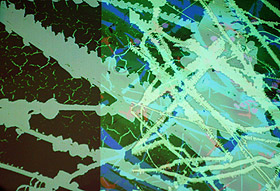 Shortly after, he started to work with slides because of the much larger scale of objects that he could project on, but he kept using the same system as with music – many slides at the same time projecting overlays at the same time. Brian Eno’s latest published work is still following the same process, his 77 Million Paintings are never the same because he designed a system that generates the images – thus in a way often rendering him a surprised audience for it as well. (While working on the piece for the Venice Biennale and after thousands of hours of listening to the generated sounds of the installation, it suddenly played the exact melody of Dolly Parton‘s song D.I.V.O.R.C.E.).
Shortly after, he started to work with slides because of the much larger scale of objects that he could project on, but he kept using the same system as with music – many slides at the same time projecting overlays at the same time. Brian Eno’s latest published work is still following the same process, his 77 Million Paintings are never the same because he designed a system that generates the images – thus in a way often rendering him a surprised audience for it as well. (While working on the piece for the Venice Biennale and after thousands of hours of listening to the generated sounds of the installation, it suddenly played the exact melody of Dolly Parton‘s song D.I.V.O.R.C.E.).
Generativity plays a role in many fields now, with gaming being no exception. Also built around this notion and probably one of the currently most eagerly awaited games is Will Wright‘s Spore, for which Brian Eno, as he revealed, will be making the soundtrack! He was asked to do it, because the designers wanted sound that is just a procedural as the game itself, instead of the loops which are tied to certain stages or areas which we are used to experience in games. He went on to demonstrate a simple software called “The Shuffler” which he uses to create fragments for the soundtrack of Spore and which even with a simple combination of samples possibly would never create the same composition twice within a lifetime. (Don’t miss the Eno/Wright-seminar at the Long Now Foundation, their podcast is a gold mine anyway)
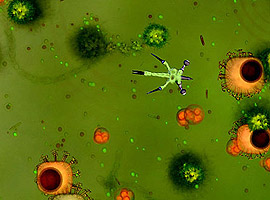 In his theory of art, the Weltanschauung changes in people’s minds, but this comes about slowly and differently for every individual. However, when something becomes possible in art, it often becomes possible in life as well. It something is different and you like it, it ultimately might change your perception of what you thought to be possible. In 21st century art, the viewer becomes an active part of the equation and is expected to communicate. Pop culture, which is always participatory, marked the beginning of something which lead to a vast new form of bottom-up mass behaviour – the Internet. With Wikipedia being an example of knowledge flowing crossways, this spirit is also increasingly spreading to science: Wikiscience is replacing the established review process and papers have sometimes hundreds of authors credited. In the past, you took things apart and studied them, but an even better way is to make them. When Craig Reynolds studied the flocking of birds in 1986, he decided to simulate flocking. It only took three simple rules (separation, alignment, cohesion) to be perfectly recreated inside a computer. Suddenly, by trying to create lifelike behavior, we understood something about life itself.
In his theory of art, the Weltanschauung changes in people’s minds, but this comes about slowly and differently for every individual. However, when something becomes possible in art, it often becomes possible in life as well. It something is different and you like it, it ultimately might change your perception of what you thought to be possible. In 21st century art, the viewer becomes an active part of the equation and is expected to communicate. Pop culture, which is always participatory, marked the beginning of something which lead to a vast new form of bottom-up mass behaviour – the Internet. With Wikipedia being an example of knowledge flowing crossways, this spirit is also increasingly spreading to science: Wikiscience is replacing the established review process and papers have sometimes hundreds of authors credited. In the past, you took things apart and studied them, but an even better way is to make them. When Craig Reynolds studied the flocking of birds in 1986, he decided to simulate flocking. It only took three simple rules (separation, alignment, cohesion) to be perfectly recreated inside a computer. Suddenly, by trying to create lifelike behavior, we understood something about life itself.
Looking at generative art this way, it may well be preparing our minds for the possibility to create life itself.

